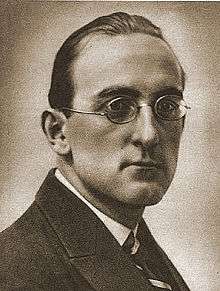Jan Lechoń
| Jan Lechoń | |
|---|---|
 Jan Lechoń | |
| Born |
Leszek Józef Serafinowicz March 13, 1899 Warsaw, Congress Poland |
| Died |
June 8, 1956 (aged 57) New York City, United States |
| Resting place | Forest Cemetery in Laski |
| Occupation | Poet |
| Language | Polish |
| Nationality | Polish |
| Literary movement | Skamander |
Leszek Józef Serafinowicz (pen name: Jan Lechoń; March 13, 1899 in Warsaw, Congress Poland, Russian Empire – June 8, 1956 in New York City) was a Polish poet, literary and theater critic, diplomat, and co-founder of the Skamander literary movement and the Polish Institute of Arts and Sciences of America.
Life
Lechoń studied Polish language and literature at Warsaw University, by which point he had already authored two collections of poetry and a play. He was co-editor of Pro arte et studio magazine. It was he who thought of the name Skamander for that literary group; he also delivered the opening speech at the group's first meeting, on 6 December 1919. During the Polish-Soviet War (1919–21) he worked in the press office of Chief of State Józef Piłsudski.
Lechoń was a member of the Pikador (Picador) literary cabaret, a member of the Polish Writers' Union, and secretary-general of the PEN Club. In 1926-29 he edited the satirical magazine Cyrulik Warszawski (The Barber of Warsaw—the title was an homage to The Barber of Seville). In 1925 he received an award from the Polish Book Publishers' Association, and in 1935 an award from the Polish Academy of Literature.[1][2]
In 1921 he attempted suicide and spent some time in a few hospitals or sanatories trying to overcome depression. A troubled homosexual affair influenced Lechon's decision to abandon Warsaw.[3] From 1930 to 1939 Lechoń was cultural attaché at the Polish embassy in Paris. After the fall of France to Nazi Germany, he left for Brazil and later settled in New York City. There he co-edited many Polish newspapers and magazines and, in 1942, co-founded the Polish Institute of Arts and Sciences of America.
After the suggestion of a psychiatrist, Lechon started writing a diary (1949–56). Amidst recondite autobiographical reminiscences, the diary is also a document of Lechon's attempt to come to terms with his homosexuality. "Oppressed by a sense of émigré obsolescence and poetic sterility, unable to resolve the conflict between his programmatically traditionalist Polish public persona and the anxieties of an aging, impecunious homosexual in an America beset by McCarthyism(...)"[4] Lechoń committed suicide on 8 June 1956 by jumping from the twelfth floor of the Hudson Hotel. At the time his motive for doing so was given as depression deepened by "social degradation". The memoirs of Adam Ciołkosz point also to depression caused by the strengthening of the communist regime in Poland.
In 1991 Lechoń's remains were exhumed from Calvary Cemetery in Queens and transferred to a cemetery in Laski, to a family tomb shared with his parents, Władysław and Maria Serafinowicz.
Work
Lechoń made his literary debut at the age of 14 with poetry collections entitled Na złotym polu (1913, In a golden field) and Po różnych ścieżkach (1914, On different paths). In 1916, his drama W pałacu Stanisława Augusta (At the palace of Stanisław August) premiered at the Old Orangery in Warsaw. His poetry collection Srebrne i czarne (Silver and black) earned him an award from the Polish Book Publishers' Association. However, growing interest in Lechoń's work and his successes in the field of poetry negatively influenced him. He found his growing status as a legend overwhelming and didn't publish further until the outbreak of World War II.
Poland's wartime demise awakened in him the passion to continue writing. He published Lutnia po Bekwarku in 1942 and Aria z kurantem in 1945, as well as Marmur i róża. Other works include Karmazynowy poemat and Iliada.
His poetry combined romantic and classicist elements, and was different from that of other Skamander members. He also translated several dramas, wrote reviews and essays.
See also
References
- ↑ "Polska Akademia Literatury". Encyklopedia Onet.pl, Grupa Onet.pl SA. 2011. Retrieved December 12, 2011.
- ↑ Jerzy Jan Lerski, Piotr Wróbel, Richard J. Kozicki (1996). Historical dictionary of Poland, 966-1945. Greenwood Publishing Group. p. 451. ISBN 0-313-26007-9. Retrieved December 5, 2011.
- ↑ Robert Aldrich, Garry Wotherspoon - Who's who in Gay and Lesbian History: From Antiquity to World War II, 307; http://andrejkoymasky.com/liv/fam/biol1/lechon01.html
- ↑ Robert Aldrich, Garry Wotherspoon - Who's who in Gay and Lesbian History: From Antiquity to World War II, 261